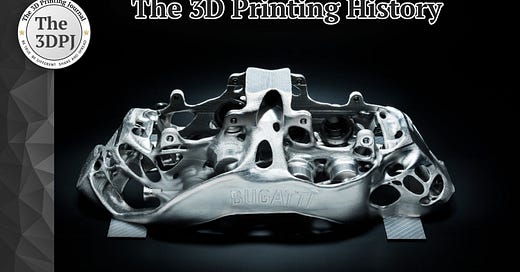01-22-2018: Bugatti created the largest 3D-printed brake caliper in the world
The caliper was developed in collaboration between Bugatti’s development team and Laser Zentrum Nord in Hamburg
On January 22, 2018, Bugatti unveiled the world’s first eight-piston monolithic brake caliper made using 3D printing technology. Manufactured from titanium, the component was also the largest brake caliper in the automotive industry. The caliper was developed in collaboration between Bugatti’s development team and Laser Zentrum Nord in Hamburg.
By 2018, 3D printing had been a part of the automotive industry for over two decades. However, for most of that time, its use was primarily limited to rapid prototyping. Bugatti’s achievement demonstrated a new trend in using metal additive manufacturing (AM) for producing functional end-use parts.
The Bugatti Chiron, the direct successor to the iconic Veyron, featured an 8-liter W16 engine with four turbochargers, delivering 1,500 horsepower at 6,700 rpm and 1,600 Nm of torque between 2,000 and 6,000 rpm.
To harness such immense power, the Chiron required an exceptionally efficient braking system, considered the most powerful in the world. To further enhance its performance, Bugatti utilized 3D printing to design and produce a new type of brake disc caliper.
The primary goal of the project was to reduce the weight of the traditional caliper. While the original model was made of aluminum, the new version was 3D-printed from titanium. The printing process was carried out by the German company Laser Zentrum Nord.
The innovative component was produced from a titanium alloy known as Ti6Al4V, commonly used in aerospace applications. This material provided a strength of 1,250 N/mm² while reducing the caliper’s weight by 40% compared to its aluminum counterpart. 3D printing enabled the creation of complex, rigid structures that were previously unattainable using conventional manufacturing methods.
The production process involved 45 hours of layer-by-layer deposition of titanium powder using four 400 W lasers. After printing, the caliper underwent heat treatment to relieve stress, followed by finishing processes such as surface smoothing and machining. The finished caliper measured 41 cm in length, 21 cm in width, 13.6 cm in height, and weighed just 2.9 kg. Initial testing of the component in vehicles was scheduled to begin in the first half of the year, with the knowledge gained planned for use in Volkswagen Group’s research and development projects.
The entire production process, including the design and testing phases, took approximately three months.
Source: www.bugatti.com





